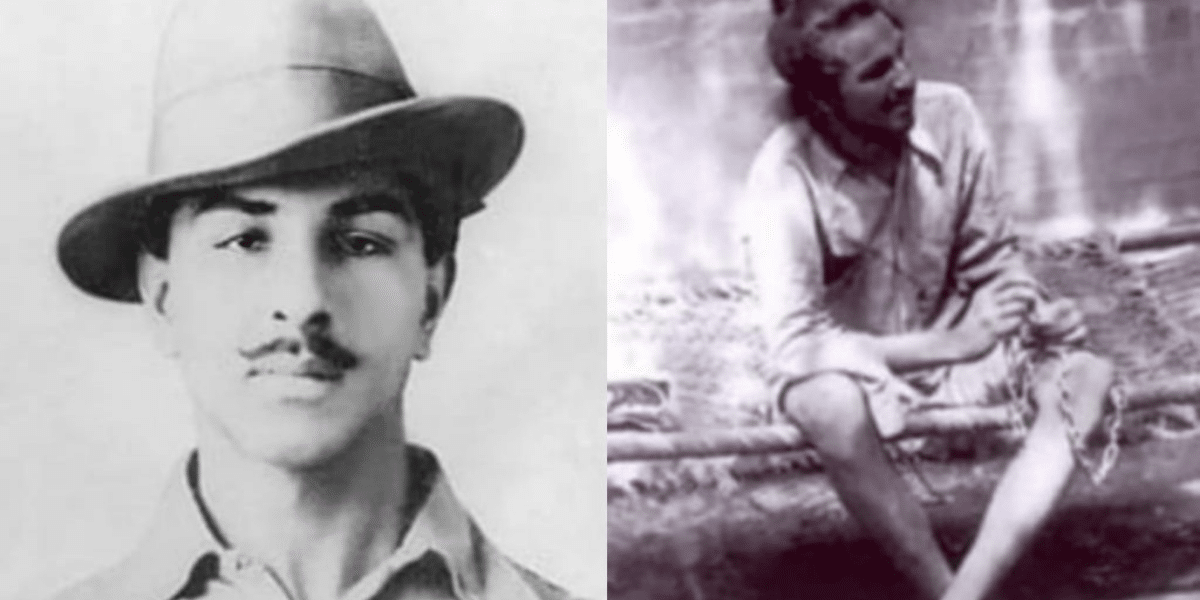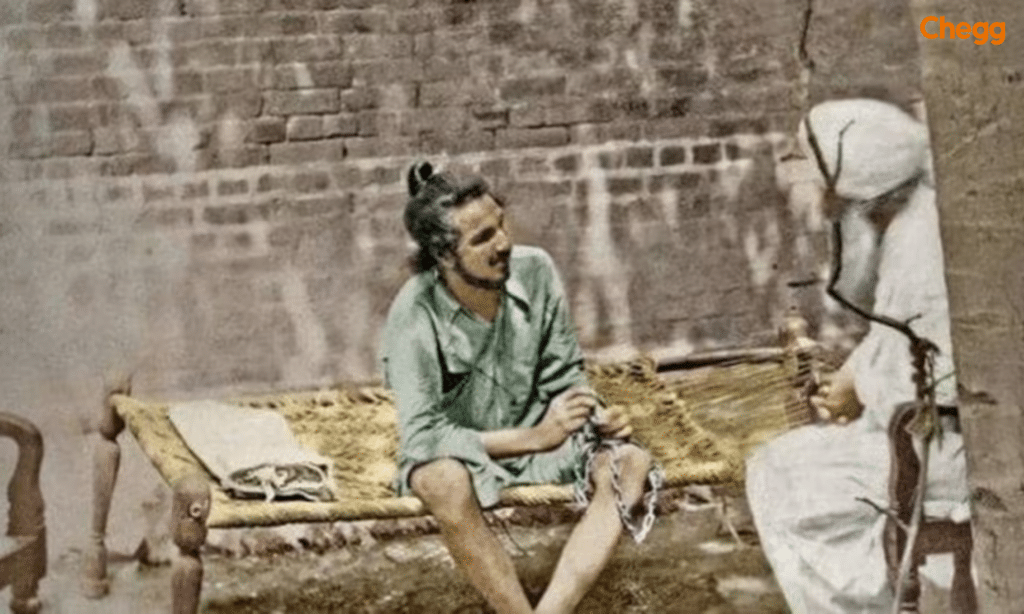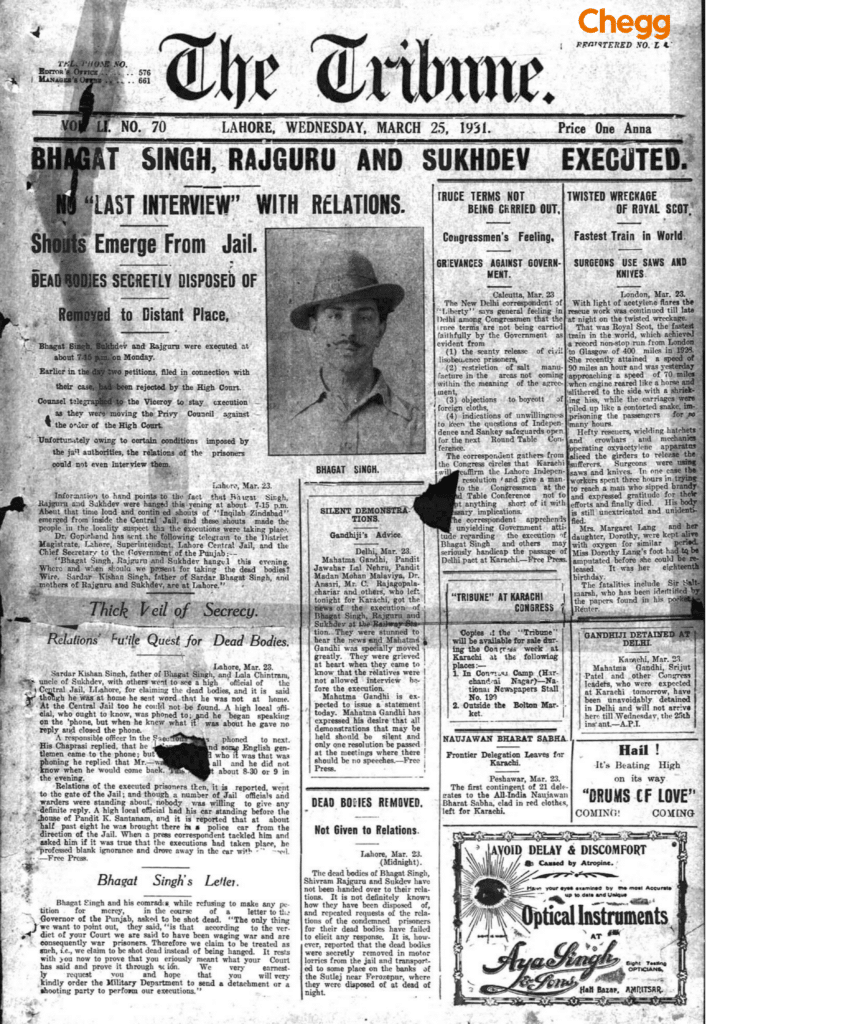
Quick Summary
Table of Contents
“Sarfaroshi Ki Tamanna, Ab Hamare Dil Mein Hai
Dekhna Hai Zor kitna Bazu-E-Qatil Mein Hai”(The Desire for Revolution is Now in Our Hearts,
-Shaheed Bhagat Singh
We shall see how much strenght lies in the arms of the enemy)
Bhagat Singh Biography: Full name Bhagat Singh (Shaheed-e-Azam Sardar Bhagat Singh) was born on September 28, 1907, in Lyallpur (now in present-day Pakistan). Bhagat Singh hailed from a Sikh family. His father, Sardar Kishan Singh Sandhu, and his uncles, Arjan Singh and Ajit Singh, actively participated in India’s struggle for independence.
At the time of Bhagat Singh’s birth, his father and uncles were imprisoned due to their involvement in the agitation against the Canal Colonization Bill in 1907. This aspect of his early life is significant in his Bhagat Singh biography, as it shaped his views on resistance and activism. The Bhagat Singh biography highlights how his family’s sacrifices for India’s freedom inspired his own revolutionary journey.
In Bhagat Singh biography, after attending a village school, Bhagat Singh enrolled in an Anglo-Vedic school in Lahore, which was run by the Arya Samaj. Later, in 1923, he joined the National College in Lahore, founded by the prominent independence activist Lala Lajpat Rai. The college aligned with Mahatma Gandhi’s call for non-cooperation with British-subsidized educational institutions.
Inspired by his family’s commitment to progressive politics, Bhagat Singh actively participated in India’s freedom struggle. This chapter in the Bhagat Singh biography showcases his early involvement in the fight for independence. The Bhagat Singh biography emphasizes how his upbringing and family values deeply influenced his determination to challenge British rule. He even visited the site of the Jallianwala Bagh massacre, where General Dyer had ordered the killing of thousands of unarmed demonstrators.
| Name | Bhagat Singh |
| Born | September 28, 1907 |
| Died | March 23, 1931 (executed) |
| Role | Indian anti-colonial revolutionary |
| Notable Acts | Mistaken murder of a British police officer in 1928 |
| Symbolic bombing of the Central Legislative Assembly in Delhi | |
| Hunger strike in jail | |
| Achievements | Martyr and folk hero in Northern India |
| Inspired India’s independence movement | |
| Urgent introspection within the Indian National Congress | |
| Borrowed ideas from Bolshevism and anarchism |

| Year | Event |
| 1907 | Born on September 28 in the village of Banga, Punjab. His family’s involvement in the Indian freedom struggle influenced him from an early age. |
| 1916 | At age 9, visited the site of the Jallianwala Bagh massacre, which fueled his desire for freedom. |
| 1919 | Witnessed the aftermath of the Jallianwala Bagh massacre in Amritsar, solidifying his resolve to fight against British rule. |
| 1920 | At age 9, he visited the site of the Jallianwala Bagh massacre, which fueled his desire for freedom. |
| 1921 | Participated in the Non-Cooperation Movement led by Mahatma Gandhi, later disillusioned with non-violence. |
| 1923 | I enrolled at Dayanand Anglo Vedic High School in Lahore and was influenced by Swami Dayanand Saraswati’s teachings on nationalism and social reform. |
| 1924 | Associated with the Hindustan Socialist Republican Association (HSRA), committed to armed struggle against British rule. |


Read More:-
Bhagat Singh’s death achieved the impact he desired, inspiring thousands of young people to join the ongoing Indian Independence movement. In his Bhagat Singh biography, it is evident that his sacrifice became a catalyst for change. Following his execution, protests erupted across Northern India, directed against both the British Raj and the perceived indifference of the Congress. The Bhagat Singh biography showcases how his martyrdom ignited a new wave of resistance that echoed across the nation.
The Communist Party of India (Marxist) recognizes Bhagat Singh’s significant contribution to Indian society, particularly his influence on the future of socialism in the country. In his Bhagat Singh biography, we see how his revolutionary ideas shaped the course of India’s political landscape. To commemorate Singh and his ideals on the centenary of his birth, a group of intellectuals established an institution in his honor. The Bhagat Singh biography continues to inspire generations, reminding us of his dedication to freedom and social justice.
Numerous popular Bollywood films have portrayed the life and legacy of Bhagat Singh. The 2006 film “Rang De Basanti” draws parallels between revolutionaries of Bhagat Singh’s era and contemporary Indian youth. In his Bhagat Singh biography, it’s worth noting that through his organization, Naujawan Bharat Sabha, Bhagat Singh trained young people to resist the British Raj. He envisioned them as courageous and patriotic, qualities he felt were lacking in modern times. His Bhagat Singh biography reflects his passion for instilling these values in the youth of India.

At the age of 12, Singh was deeply affected by the Jallianwala Bagh Massacre in Amritsar, where British forces fired on a peaceful gathering, killing hundreds and injuring over a thousand. This tragic event ignited his desire to fight for India’s independence. He soon became involved in the noncooperation movement led by Mahatma Gandhi, which aimed to pressure the British government to grant India self-rule (swaraj). However, Singh grew disillusioned when Gandhi suspended the movement following the violent Chauri Chaura incident, where protesters killed 23 police officers.
During his time at the National College, Singh became associated with the Hindustan Republican Association, a revolutionary left-wing group. On his suggestion, the organization was later renamed the Hindustan Socialist Republican Association. In 1926, he founded the Naujawan Bharat Sabha (Youth Society of India). Singh also contributed as a writer and editor for Punjabi and Urdu newspapers in Amritsar, promoting Marxist ideologies. He played a key role in popularizing the revolutionary slogan “Inquilab Zindabad”.
Bhagat Singh biography tells the story of a remarkable freedom fighter who did great work to gain freedom from the Britishers and against Colonial Rule. He was fondly called ‘Shaheed Bhagat Singh’. His Bhagat Singh biography highlights his role in growing India’s militancy in the 1930s by borrowing from Anarchism and Bolshevik ideas. The Bhagat Singh biography is a testament to his courage, intellect, and unwavering dedication to the cause of India’s independence. His legacy continues to inspire generations of Indians fighting for justice, equality, and national pride.
Bhagat Singh is famous for his fearless fight against British colonial rule and his role in India’s freedom struggle. He became a national hero for his revolutionary actions, including the Lahore Conspiracy Case and the bombing of the Central Legislative Assembly. Known for his slogan “Inquilab Zindabad” and his martyrdom at the young age of 23, Bhagat Singh symbolizes courage, patriotism, and the spirit of sacrifice.
His last Wish in his words, “We wanted to point out that according to the verdict of your court, we had waged war and were therefore war prisoners. And we claim to be treated as such, i.e., we claim to be shot dead instead of being hanged. It rests with you to prove that you meant what your court has said.”
He was executed on March 23, 1931, after being found guilty of killing a British police officer. Thus, we can conclude that Bhagat Singh, also known as Shaheed-e-Azam, was a martyr who gave his life in defense of the nation.
The life of Bhagat Singh serves as motivation for those who struggle for injustice and justice. He was a courageous young guy who devoted his entire life to the Indian independence movement. His tale serves as a reminder that triumph is achievable even in the face of extreme adversity.
1. Revolutionary Fighter: Bhagat Singh was a key figure in India’s independence movement.
2. Martyr: Executed by the British in 1931 at age 23.
3. Hunger Strike: Led a hunger strike for prisoner rights in jail.
4. Ideology: Advocated for armed struggle and socialist principles.
5. Legacy: Remembered as a national hero and symbol of courage.
Bhagat Singh was a prominent Indian freedom fighter known for his courage and revolutionary ideas against British rule. Born on September 28, 1907, in Punjab, he became a symbol of youth-led resistance. He was involved in the Lahore Conspiracy Case and was executed on March 23, 1931, at the age of 23. His sacrifice inspired generations and remains a powerful symbol of India’s independence movement.
Bhagat Singh death occurred on March 23, 1931, due to his involvement in the Lahore Conspiracy Case and revolutionary actions against British rule.

Authored by, Muskan Gupta
Content Curator
Muskan believes learning should feel like an adventure, not a chore. With years of experience in content creation and strategy, she specializes in educational topics, online earning opportunities, and general knowledge. She enjoys sharing her insights through blogs and articles that inform and inspire her readers. When she’s not writing, you’ll likely find her hopping between bookstores and bakeries, always in search of her next favorite read or treat.
Editor's Recommendations
Chegg India does not ask for money to offer any opportunity with the company. We request you to be vigilant before sharing your personal and financial information with any third party. Beware of fraudulent activities claiming affiliation with our company and promising monetary rewards or benefits. Chegg India shall not be responsible for any losses resulting from such activities.
Chegg India does not ask for money to offer any opportunity with the company. We request you to be vigilant before sharing your personal and financial information with any third party. Beware of fraudulent activities claiming affiliation with our company and promising monetary rewards or benefits. Chegg India shall not be responsible for any losses resulting from such activities.